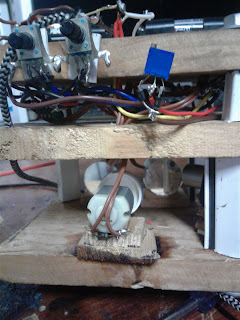38. Crude laser spirograph
 |
| <Entire active unit> |
Each of the motors relies on the 555 motor driver, which includes the 555 as the core of the driver, a potentiometer, for adjusting the speed of the motor, and miscellaneous components, such as the bd139 transistor, 2 ceramic capacitors, 2 diodes, and an additional resistor. Once the components were combined, they form a PWM circuit so that the motor spun; according to the duty cycle created by the 555. The potentiometer adjusts the signal going through the 555, which 555 converts the signal into a PWM wave, which passes to the transistor. The transistor acts as a switch, and so it turns the on and off to the signal to the point where it runs the motor.
 |
| <Iso-view> |
The laser was then powered by 4.5 volts, and was shot to the 3 mirrors, each of which can be spun by the motors, and reflects back to the outer side, which in this case, is a wall. As the motor moves, the mirror spins, and so the laser that is reflected on the spinning mirrors spins as well. Once the laser gets to all 3 spinning mirrors, it then presents the final image to the other side.
 |
| <Front view> |
Everything was housed in a "shelf-like" cabinet, where at each level, you can put the parts that were required to create the laser. For example, the bottom layer will be where the motors and the module will be, just remember where the laser reflects which of the motor, as well as the motor's position. Without doing this check, the laser might not get through the designated mirrors, or just reflect on a different spot. The second layer represents all of the circuitry that drives the motor, specifically, the 555s. And the last layer will be the battery holders.
 |
| <Back view> |
It's a strange phenomenon of how the laser moves once the mirror is spinning, though the image is basically a laser dot moving at a faster speed. The persistence of vision, however, makes it possible that us to see the fast-moving laser as one image. It's a satisfying way to see the show, and since it's controllable, you can make as many spirograph designs as you can.



Comments